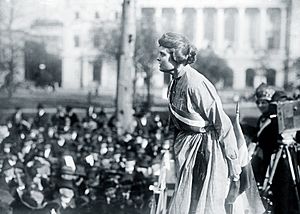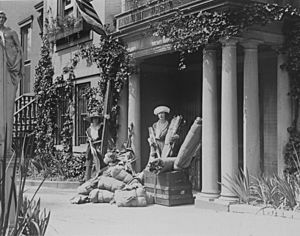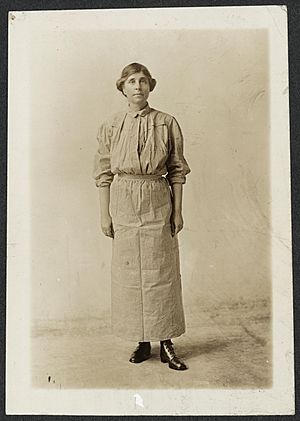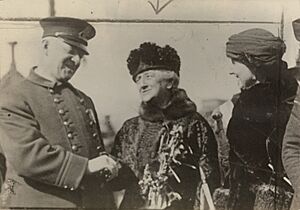Prison Special facts for kids

The "Prison Special" was a special train tour organized by women who fought for the right to vote. These women were called suffragists. Many of them had been put in jail for protesting outside the White House. They wanted a new law, called an amendment, to give women across the country the right to vote.
In February 1919, 26 members of the National Woman's Party started their journey. They rode a special train they called the "Democracy Limited" from Washington, D.C.. They traveled to many cities, telling large groups of people about their time in jail. They were treated like political prisoners at a place called Occoquan Workhouse. To show what they had been through, they often wore replicas of their prison uniforms. The tour ended in March 1919. It helped build strong support for the Nineteenth Amendment. This important amendment, giving women the right to vote, was officially adopted on August 26, 1920.
Contents
Why the Prison Special Started
In the summer of 1917, members of the National Woman's Party (NWP) began protesting. They stood outside the White House in Washington, D.C., demanding that women get the right to vote. Many of these women were arrested. They were often charged with blocking traffic and had to pay fines.
When they refused to pay the fines, they were sent to jail. At first, their jail time was short. But as the Silent Sentinels (the name for these protesters) kept up their peaceful protests, the sentences became much tougher. In July and August 1917, some women were jailed for 60 days. Many were sent to Occoquan Workhouse in Virginia.
These women believed they were political prisoners. This meant they were jailed for their beliefs, not for a crime. Because of this, they refused to eat prison food or do prison work. They also would not wear the rough prison uniforms. By the fall, some women went on a hunger strike, refusing to eat. They were then force-fed.
Public pressure eventually made officials release the women from Occoquan. But arrests continued through 1918. The NWP worked even harder to get the women's suffrage amendment passed. In early 1919, NWP members lit "watch fires" at the White House and nearby Lafayette Park. This led to more arrests. In total, 168 women served time in prison.
In February 1919, the women's suffrage amendment failed in the Senate by just one vote. To get more public support and pressure lawmakers, the NWP started the "From Prison to People" campaign. This was a three-week train tour across the United States.
The Tour Across America
The "Prison Special" train tour aimed to teach people about how the government treated suffragists. It would stop in 16 cities across the United States. The women wanted to show how they were arrested, jailed, and mistreated for supporting women's right to vote.
The NWP members on the special train, called "The Democracy Limited," were important leaders. They included Abby Scott Baker, Lucy Gwynne Branham, Lucy Burns, Mary Nolan (the NWP's oldest protester), Vida Milholland, and Mabel Vernon.
To share their message, they gave speeches in rented halls, from train platforms, and even from cars. They sang jail songs they learned in prison, like "The Women's Marseillaise". They also acted out their arrests and handed out flyers. One important thing they did was wear copies of their prison uniforms. These uniforms were described as "calico wrappers" that looked exactly like what they wore in jail. This made their stories much more real for the audiences.
The tour was expensive, costing about $20,000. This money came from NWP groups in different states and from individual donations. Louisine Havemeyer, a wealthy supporter of women's rights, gave $1500. William B. Thompson, a businessman, paid for the flyers and other materials. Ella Riegel managed the tour's plans, and Abby Scott Baker handled publicity.
Tour Stops and Speeches
The Prison Special left Washington, D.C., on February 15, 1919. This date was the birthday of famous women's rights activist Susan B. Anthony. The train stopped in many cities, including:
- Charleston, South Carolina
- Jacksonville, Florida
- Chattanooga, Tennessee
- New Orleans, Louisiana
- San Antonio, Texas
- Los Angeles, California
- San Francisco, California
- Denver, Colorado
- Chicago, Illinois
- Milwaukee, Wisconsin
- Detroit, Michigan
- Syracuse, New York
- Boston, Massachusetts
- Hartford, Connecticut
- New York, New York
The tour first went through Southern states. The NWP hoped to change the minds of the Democratic Party there, who were against women's suffrage. Then, they went to Western states. Here, many women could already vote in their states. The NWP wanted them to support a national amendment. Finally, the tour went through Northern states and the Northeast, ending in New York City.
The Prison Special also made some unplanned stops. In El Paso, Texas, the train had a problem, forcing an overnight stay. The local newspaper, the El Paso Herald, reported that Lucy Burns, Amelia Himes Walker, Elizabeth McShane, and Sue Shelton White spoke about suffrage. Other suffragists gave out flyers. They carried flags with the suffrage colors: gold, purple, and white. They stood on a step to speak through a train platform grill, which looked like prison bars.
Abby Scott Baker shared how hard it was to speak in public. She said, "It is not easy to begin speaking on the street." She explained that you have to start talking to the air. But if you keep going, people will get interested.
The women who went on the Prison Special tour had all been jailed for supporting women's right to vote. Some of them included:
- Pauline Adams
- Abby Scott Baker
- Lucy Gwynne Branham
- Lucy Burns
- Louisine Havemeyer
- Vida Milholland
- Mary Nolan
- Ella Riegel
- Mabel Vernon
- Sue Shelton White
- Mary Winsor
How They Got Their Message Out
The women on the Prison Special had experience with train tours. They had worked on the "Suffrage Special" in 1916. By 1919, the NWP wanted this new tour to show how the government tried to stop their peaceful fight for suffrage. The women would share details about their time in prison.
They first wanted to paint their train car to look like prison cells. But the Railway Administration would not allow it. They could not paint the cars to look like prison cells or use any other signs showing their purpose.
Instead, the women decided to wear their prison uniforms in public. These uniforms were described as "heavy, shapeless dresses" and "underclothing of unbleached muslin." They were uncomfortable, hot in summer and cold in winter. Two years after being jailed, the women used these uniforms to show how hard their struggle was.
Wearing the prison uniform helped make their fight for women's suffrage more dramatic. Newspapers often wrote about how "refined" and "educated" these women were. They noted that these were "women of wealth who have chosen to humiliate themselves." This made people feel that if these well-off women were treated badly, it was a serious problem.
The programs at each stop were a bit different, but some speakers were always featured. Louisine Havemeyer often spoke first. She was introduced as a grandmother of 11 children and one of New York's richest women. She often spoke about how women's suffrage was a fair cause. Newspapers praised her calm and dignified manner. Abby Scott Baker usually spoke next. Other speakers included Lucy Burns, Mary Winsor (who spent 66 days in jail), and Lucy Branham. Often, while one woman spoke, others in their prison clothes stood silently behind her.
Besides giving out the "Jailed for Freedom" flyer, the women also shared a list of complaints against President Wilson. They pointed out that he said he supported women's suffrage but did nothing to help it pass. A cartoon by Nina Allender, the NWP's official cartoonist, showed a suffragist about to board the Prison Special. During the tour, the women held large meetings. They were often met by groups of women from local clubs and other organizations. The women on the Prison Special also used "motion pictures," probably a magic lantern show, to visually share their prison experiences.
The women on the Prison Special tour were very good at getting publicity. Louisine Havemeyer wrote in Scribner's Magazine about being asked to take a photo with a police captain. She made sure the captain was shaking her hand in the picture. This was so no one would think she was being arrested during the tour.
How People Reacted
The Prison Special definitely attracted large crowds. Abby Scott Baker reported that police estimated 2,000 people attended the stop in Charleston, South Carolina. However, not everyone was happy to see them. Some newspapers said the meetings encouraged "unnatural feminine sentiments." Other suffragists wanted to distance themselves from the NWP's more radical actions. For example, NWP members had burned a dummy of President Wilson the year before.
In Columbia, South Carolina, the mayor warned the women that "disloyal utterances would not be tolerated." The Equal Franchise League in El Paso, Texas, stated it did "not in sympathy with the militant suffraget class." However, often the crowds supported the Prison Special women. They would boo and hiss at the stories of their treatment, shouting "Shame! Shame on our government!"
What Happened Next
Just three months after the Prison Special tour ended, Congress voted to pass the 19th Amendment in June 1919. States then began to approve the amendment one by one. The 19th Amendment was successfully adopted a year later, in August 1920. This finally gave women the right to vote across the United States.
The NWP, along with several members of the Prison Special tour, continued to fight for women's rights. They supported the Equal Rights Amendment, which aims to ensure equal rights for all Americans regardless of sex. This struggle for full equality continues even today.
See also
 In Spanish: Prison Special para niños
In Spanish: Prison Special para niños




